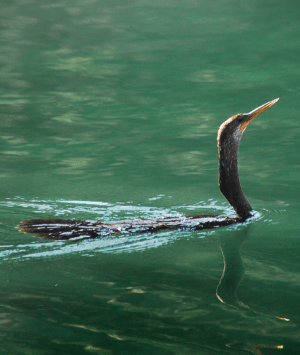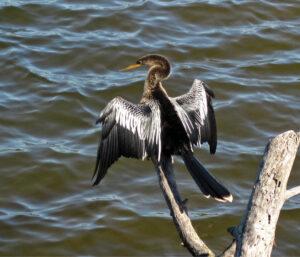 When birdwatching near Florida’s lakes and marshes, there are some familiar faces you expect to see, such as ducks, geese, and herons. However, if you keep your eyes peeled, you can spot a rarer native bird diving into the water or sunning its outstretched silvery wings on the shore. Sometimes referred to as the “snake bird” or “water turkey,” the anhinga does not float atop the water like a duck or wade like a heron. It swims beneath the surface of the water to hunt its prey, which includes small fish, aquatic insects, and even baby alligators. When swimming at the surface, only its s-shaped neck appears out of the water, giving the appearance of a snake waiting to strike and leading to its nickname “snake bird.” This bird has some unique and surprising features that make it a master of both the water and the sky. Read on to learn all about the amazing anhinga.
When birdwatching near Florida’s lakes and marshes, there are some familiar faces you expect to see, such as ducks, geese, and herons. However, if you keep your eyes peeled, you can spot a rarer native bird diving into the water or sunning its outstretched silvery wings on the shore. Sometimes referred to as the “snake bird” or “water turkey,” the anhinga does not float atop the water like a duck or wade like a heron. It swims beneath the surface of the water to hunt its prey, which includes small fish, aquatic insects, and even baby alligators. When swimming at the surface, only its s-shaped neck appears out of the water, giving the appearance of a snake waiting to strike and leading to its nickname “snake bird.” This bird has some unique and surprising features that make it a master of both the water and the sky. Read on to learn all about the amazing anhinga.
The anhinga is a freshwater bird that can be found in Florida all year round, especially in the Everglades. It can also be found along the coast in Mexico and Central America. It looks similar to a cormorant, but it is actually a member of the darter family, a type of bird that spears fish with its sharp, thin beak. The anhinga is a solitary bird that prefers to nest in mixed groups of other species, such as herons and ibises, rather than among its own kind. When anhingas do get together, they can be very territorial and defend their land by pecking at the others’ heads and necks. Anhingas mate for life and may reuse the same nest year after year.
 To hunt, the anhinga stealthily swims beneath the surface of the water. It can stay submerged for over a minute. Its neck has specialized hinge-like vertebrae that allows it to thrust toward its prey at incredible speeds, and serrations across the sides of its beak ensure that the fish cannot escape. Unlike most water birds, it lacks the oil glands that provide waterproofing to its feathers, meaning it is not water resistant and it cannot float. While this seems like quite the disadvantage, the anhinga adapts this strange feature into its hunting technique. The weight of its soaked feathers allows it to swim beneath the surface of the water and dive deep to spear its food.
To hunt, the anhinga stealthily swims beneath the surface of the water. It can stay submerged for over a minute. Its neck has specialized hinge-like vertebrae that allows it to thrust toward its prey at incredible speeds, and serrations across the sides of its beak ensure that the fish cannot escape. Unlike most water birds, it lacks the oil glands that provide waterproofing to its feathers, meaning it is not water resistant and it cannot float. While this seems like quite the disadvantage, the anhinga adapts this strange feature into its hunting technique. The weight of its soaked feathers allows it to swim beneath the surface of the water and dive deep to spear its food.
This lack of water resistance does mean that the anhinga takes longer to dry, which is why it can often be seen perched on a branch with its wings outstretched and its back to the sun. This signature pose also helps to absorb heat energy, which is important for a bird that is constantly wet, has an unusually low metabolism, and lacks the insulated layer of down that most water birds rely on to keep warm. On the other hand, its sleek wings make the anhinga an excellent flier, and one of the few water birds that can soar. When flying, its long tail sticks out prominently behind it, earning its second nickname, “water turkey.” When dry, it is known to soar to great heights by riding thermals, or currents of warm air, high into the sky without having to flap its wings.
 The anhinga is different from other water birds in several ways: its swimming style of hunting, its lack of waterproofing, its signature outstretched sunning pose, and its ability to soar. These unique features, and its preferred home of the Everglades, solidify its position as an iconic native bird of Florida. Though they can be difficult to spot due to their solitary nature, these birds have an abundant population. Their only natural predator is the alligator, and their only major threat is urbanization, wetland draining, and other forms of habitat loss. Next time you find yourself near one of Florida’s many beautiful lakes or marshes, look for a bird perched with its wings outstretched, or a snake-like head poking out of the water. You may catch a glimpse of the amazing anhinga.
The anhinga is different from other water birds in several ways: its swimming style of hunting, its lack of waterproofing, its signature outstretched sunning pose, and its ability to soar. These unique features, and its preferred home of the Everglades, solidify its position as an iconic native bird of Florida. Though they can be difficult to spot due to their solitary nature, these birds have an abundant population. Their only natural predator is the alligator, and their only major threat is urbanization, wetland draining, and other forms of habitat loss. Next time you find yourself near one of Florida’s many beautiful lakes or marshes, look for a bird perched with its wings outstretched, or a snake-like head poking out of the water. You may catch a glimpse of the amazing anhinga. ![]()
Jessica Fuller
Home & Yard Magazine


